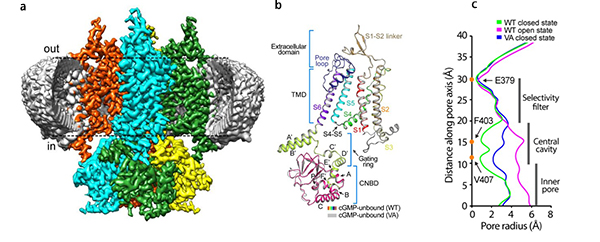A research team led by Prof. LI Guohui from the Dalian Institute of Chemical Physics (DICP) of the Chinese Academy of Sciences, in cooperation with Prof. YANG Jian and Prof. Joachim Frank from Columbia University, revealed the mechanism of ligand activation of a eukaryotic cyclic nucleotide-gated (CNG) channel. The results were published in Nature Structural & Molecular Biology.
CNG ion channels are mainly distributed in the central nervous system of higher vertebrates. They are closely related to visual nerve sensing and olfactory nerve sensing.
In visual cells, the photoactivation of light-sensitive pigments reduces the concentration of intracellular cyclic guanosine monophosphate (cGMP) ligand, resulting in the closure of CNG channels and the hyperpolarization of the cell membrane.
In olfactory neurons, the activation of olfactory receptors by odorant molecules leads to an increase in intracellular cyclic adenosine monophosphate (cAMP) ligand concentration, resulting in the opening of CNG ion channels and depolarization of the cell membrane.
Certain pathogenic mutations in the CNG ion channel gene are the direct causes of insomnia and color blindness. Therefore, the study of the gating mechanism of CNG ion channels is of great significance for understanding the related pathogenic mechanisms and biological processes.
Previous research indicated that the key gating amino acid of CNG ion channel is E379 located in the extracellular region of the protein. However, Prof. LI’s team found that the F403 and V407 located on the S6 helix along the ion channel play the key gating role by theoretical simulations.
In order to further confirm the new theoretical findings, Prof. YANG and Prof. Frank resolved the CNG channel in open state, closed state as well as F403/V407 double mutation through the single particle cryo-EM technology with high-resolution at the atomic level. And the electrophysiological experiments further confirmed the core role of F403 and V407 double traps in regulating the ion transmission of CNG channels.
This work provides a new understanding of the molecular basis of the CNG ion channel gating mechanism. (Text by LI Guohui and ZHANG Yuebin)

a)Cryo-EM density map of CNG channel; b)Superposition of cGMP-unbound and cGMP-bound monomer ; c)Pore-size profiles of open, closed and F403/V407 dual mutation states.(Image by LI Guohui and ZHANG Yuebin)